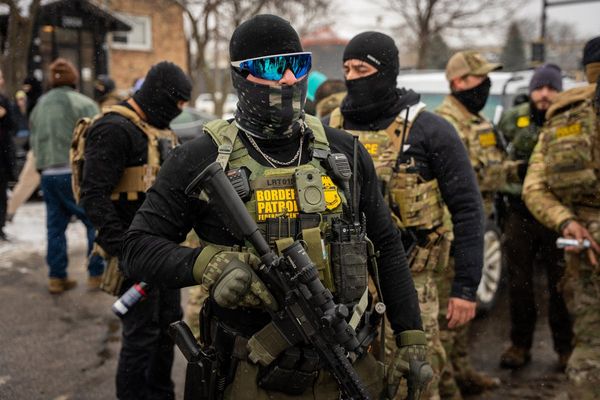
In the dark and the cloying heat of a Gaza night, the troops of the 13th Battalion of Israel’s Golani Brigade were attempting to advance in northern Gaza amid the flashes of air and artillery strikes across the Gaza Strip.
The ambush, when it happened, caught them by surprise – 30 fighters from an elite Hamas unit emerging from hidden tunnel entrances.
The prolonged battle that followed saw Hamas deploy drones, anti-tank missiles and mortars against the Israeli armoured personnel carriers (APCs).
At one stage, according to reports, the Hamas unit tried to gain access to the vehicles, in the midst of furious combat that left 20 of them dead while 10 managed to escape.
“They emerged from tunnels, surrounding us, launching rocket-propelled grenades at us, and attempting to approach our armoured personnel carriers to set explosives,” said the battalion’s commander, Lt Col Tomer Greenberg, speaking to Israeli media after the engagement.
In a radio recording shared by the Israel Defence Forces (IDF), Greenberg can be heard calling urgently for help. “We’ve received a significant attack here. Assault attempts. I need suppressing fire to repel the terrorists’ attacks. Anyone who is outside the APCs, kill [them].”
As Israel’s ground invasion has pushed forward in the past seven days, it has been marked by ambushes on tanks, on troop concentrations and positions taken in shattered, bomb-damaged buildings.

Vehicles have been engaged with anti-tank guided missiles and have run over mines, leading to a steady stream of Israeli casualties, even while the IDF has claimed to have killed scores of Hamas fighters in the fierce unfolding battles as Israeli columns have closed on Gaza City on three sides, fighting their way into the dense urban areas.
The cost has been dramatised in the daily funerals and obituaries for the two dozen Israeli soldiers who have died so far.
As the ground war enters its second brutal week, the unanswered questions driving its logic have become ever more pressing. Can the war aims be achieved? And what happens on the day after the shooting stops?
Strikingly, unlike in previous rounds of conflict in Gaza, the strong sense of social solidarity in wartime exists this time in tandem with a furious debate over whether the public rhetoric of Israel’s political and military leaders is reflective of reality.
The picture of the Israeli ground war in Gaza has emerged piecemeal: from official briefings, where details have been kept deliberately vague; from the obituaries of fallen Israeli soldiers and fragments of video footage released by the IDF and Hamas; and from satellite images of Gaza.
As Israeli armour has moved forward, it has faced an array of challenges: hidden tunnel entrances shielding anti-tank teams, mined routes, booby traps and drones dropping munitions.
Speaking last week, Brig Gen Iddo Mizrahi, the head of Israel’s military engineers, said on army radio that troops were only in a first stage of opening access routes in Gaza.
“This is certainly terrain that is more heavily sown than in the past with minefields and booby traps,” he said. “Hamas has learned and prepared itself well.”
That has led Israeli forces to bulldoze lanes through the rubble of destroyed buildings with huge Caterpillar D9 armoured bulldozers to bypass the approach routes that they fear have been mined.
“We are at the gates of Gaza City,” said Israeli commander Brig Gen Itzik Cohen, later adding that Hamas and Islamic Jihad fighters were emerging from tunnels to fire at tanks then disappearing back into the warren.
The starkest illustration of that threat came on Tuesday in the heaviest loss of life on the IDF’s side of the ground invasion, when a Namer APC was hit around noon on Tuesday by an anti-tank guided missile, leaving nine soldiers dead.
But beyond those killed in the fighting, there has also been a heavy toll of wounded.
Deliberately blurred video footage released last week by the IDF showed hectic military evacuation flights by Unit 669, an elite search and rescue force, which has so far flown 150 missions into Gaza to medevac about 260 injured Israeli soldiers, sometimes under fire.
All of which raises the question: to what end? It is a question that has been aired increasingly by Israeli media, by officials in private briefings, by analysts and foreign diplomats.
So far, despite the claimed successes, Israel has yet to create the conditions for its first and most pressing objective: the release or rescue of more than 240 hostages held by Hamas. Rocket fire, too, has continued from within Gaza.
In past Gaza conflicts, despite the claims of heavy Hamas losses, including commanders, the militant group has emerged battered but still functioning from the rubble. While this war was supposed to be different, some Israelis are already wondering how different it really is.
Doubts have been expressed in some unlikely places. In the centrist and usually fiercely patriotic Israeli newspaper Yedioth Ahronoth, commentator Nadav Eyal last week summed up the growing perception that, despite the public statements, Benjamin Netanyahu’s government may be edging towards the default position of all past Gaza invasions – a campaign against Hamas that remains somehow incomplete.

“The government has been speaking in two voices,” wrote Eyal. “In one voice, it has promised to vanquish Hamas, to completely destroy its military capabilities. Hamas won’t control the Gaza Strip any more, ever again.
“Behind closed doors, however, government officials have been speaking more equivocally. In those conversations, toppling Hamas has become an abstract objective, one that will take years to achieve. Facts will be established on the ground, such as a security zone, and that will be complemented by ‘assassinations’, ‘raids’ and a ‘campaign that will last for years’.”
In the conservative Jerusalem Post, doubts have emerged about how much progress has realistically been made – whether Israel “will move fast enough and skilfully enough to end the Hamas threat after over 15 years remains the open question”.
Even more bleak has been the assessment of Nathan Brown in an essay for the Carnegie Endowment for International Peace considering not only what may happen on the “day after” – should Israel actually defeat Hamas – but whether a conventional victory is possible.
“What does victory mean?” asks Brown. “And whatever its goals, what will Israel actually achieve? How will anyone know that the war is over? These better questions show why it is a mistake for scenarios to assume a ‘day after’ as if this were a conventional war that will clearly and cleanly give way to agreed or imposed postwar arrangements.”
It is an outcome, in any case, that may well be shaped – as in previous rounds of fighting – by factors beyond Israel’s control, not least a familiar trajectory of horror at the civilian Palestinian casualties of Israeli bombing of Gaza, whose impact, inexorably, has led in the past to US and international pressure for humanitarian pauses and then a halt in the fighting. It is a process that is occurring even now as the White House pushes for a pause.
Until then one thing is clear. The dying will continue, Palestinians in Israeli strikes and the young soldiers trying to advance as the world wonders what comes next.







